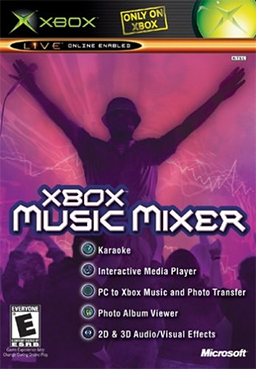Related Research Articles

Karaoke is a type of interactive entertainment usually offered in clubs and bars, where people sing along to recorded music using a microphone. The music is an instrumental version of a well-known popular song. Lyrics are typically displayed on a video screen, along with a moving symbol, changing colour, or music video images, to guide the singer. In Chinese-speaking countries and regions such as mainland China, Hong Kong, Taiwan and Singapore, a karaoke box is called a KTV. The global karaoke market has been estimated to be worth nearly $10 billion.
Multimedia is a form of communication that uses a combination of different content forms such as text, audio, images, animations, or video into a single interactive presentation, in contrast to traditional mass media, such as printed material or audio recordings, which features little to no interaction between users. Popular examples of multimedia include video podcasts, audio slideshows and animated videos. Multimedia also contains the principles and application of effective interactive communication such as the building blocks of software, hardware, and other technologies. The five main building blocks of multimedia are text, image, audio, video, and animation.
Hypermedia, an extension of the term hypertext, is a nonlinear medium of information that includes graphics, audio, video, plain text and hyperlinks. This designation contrasts with the broader term multimedia, which may include non-interactive linear presentations as well as hypermedia. It is also related to the field of electronic literature. The term was first used in a 1965 article written by Ted Nelson.
Context awareness refers, in information and communication technologies, to a capability to take into account the situation of entities, which may be users or devices, but are not limited to those. Location is only the most obvious element of this situation. Narrowly defined for mobile devices, context awareness does thus generalize location awareness. Whereas location may determine how certain processes around a contributing device operate, context may be applied more flexibly with mobile users, especially with users of smart phones. Context awareness originated as a term from ubiquitous computing or as so-called pervasive computing which sought to deal with linking changes in the environment with computer systems, which are otherwise static. The term has also been applied to business theory in relation to contextual application design and business process management issues.

In computing, a visual programming language or block coding is a programming language that lets users create programs by manipulating program elements graphically rather than by specifying them textually. A VPL allows programming with visual expressions, spatial arrangements of text and graphic symbols, used either as elements of syntax or secondary notation. For example, many VPLs are based on the idea of "boxes and arrows", where boxes or other screen objects are treated as entities, connected by arrows, lines or arcs which represent relations.
An audio game is an electronic game played on a device such as a personal computer. It is similar to a video game save that there is audible and tactile feedback but not visual.

The LaserActive is a converged device and fourth-generation home video game console capable of playing LaserDiscs, Compact Discs, console games, and LD-G karaoke discs. It was released by Pioneer Corporation in 1993. In addition to LaserActive games, separately sold add-on modules accept Mega Drive/Genesis and PC Engine/TurboGrafx-16 ROM cartridges and CD-ROMs.

Katie Salen Tekinbas is an American game designer, animator, and educator. She is a professor at the University of California, Irvine. Previously, she taught at DePaul University College of Computing and Digital Media, Parsons The New School for Design the University of Texas at Austin, New York University, and the Rhode Island School of Design. She has an MFA in graphic design from the Rhode Island School of Design.

A handheld projector is an image projector in a handheld device. It was developed as a computer display device for compact portable devices such as mobile phones, personal digital assistants, and digital cameras, which have sufficient storage capacity to handle presentation materials but are too small to accommodate a display screen that an audience can see easily. Handheld projectors involve miniaturized hardware, and software that can project digital images onto a nearby viewing surface.
Evolutionary music is the audio counterpart to evolutionary art, whereby algorithmic music is created using an evolutionary algorithm. The process begins with a population of individuals which by some means or other produce audio, which is either initialized randomly or based on human-generated music. Then through the repeated application of computational steps analogous to biological selection, recombination and mutation the aim is for the produced audio to become more musical. Evolutionary sound synthesis is a related technique for generating sounds or synthesizer instruments. Evolutionary music is typically generated using an interactive evolutionary algorithm where the fitness function is the user or audience, as it is difficult to capture the aesthetic qualities of music computationally. However, research into automated measures of musical quality is also active. Evolutionary computation techniques have also been applied to harmonization and accompaniment tasks. The most commonly used evolutionary computation techniques are genetic algorithms and genetic programming.

The Xbox Music Mixer is a multimedia utility developed by Wild Tangent and published by Microsoft Game Studios for the Xbox in 2003. The software allows the user to transfer certain types of music and pictures directly from a PC to the Xbox, create custom soundtracks, and features a karaoke mode to sing pre-loaded or custom songs using a packaged karaoke microphone. Xbox Music Mixer was announced at E3 in 2003 as part of a 'Digital Entertainment Lifestyle' initiative, with expectations that the software would lead the console towards functionality as an all-in-one media centre. Upon release, the software received negative reception, with reviewers observing compatibility and usability issues and limitations to the game's karaoke features. The software was subsequently influential to the features of the similar Windows Media Center Extender for the Xbox 360.
Lips is a 2008 karaoke video game for the Xbox 360. Lips was developed by iNiS and published by Microsoft Game Studios. The game features the use of motion sensitive wireless microphones and supports the use of songs already owned through a Zune or iPod. Lips has spawned three sequels: Lips: Number One Hits, Lips: Party Classics, and Lips: I Love the 80's. Localized versions of the game and sequels have been released in several countries, including Lips: Canta en Español, and Deutsche Partyknaller.
A human-based computation game or game with a purpose (GWAP) is a human-based computation technique of outsourcing steps within a computational process to humans in an entertaining way (gamification).
Susanne Boll is a Professor for Media Informatics and Multimedia Systems in the Department of Computing Science at the University of Oldenburg, Germany. Boll is a member of SIGMM of the ACM and is a member of the board at the research institute OFFIS. She founded and directs the HCI Lab at the University of Oldenburg and OFFIS.
Tunebot is a music search engine developed by the Interactive Audio Lab at Northwestern University. Users can search the database by humming or singing a melody into a microphone, playing the melody on a virtual keyboard, or by typing some of the lyrics. This allows users to finally identify that song that was stuck in their head.
Sergi Jordà is a Catalan innovator, installation artist, digital musician and Associate Professor at the Music Technology Group, Universitat Pompeu Fabra in Barcelona. He is best known for directing the team that invented the Reactable. He is also a trained Physicist.
LV-ROM is an optical disc format developed by Philips Electronics to integrate analog video and computer software for interactive multimedia. The LV-ROM is a specialized variation of the CAV Laserdisc. LV-ROM is an initialism for "LaserVision Read-Only Memory".
Seven45 Studios is the video game publishing & development division of First Act. The company's titles fuse innovative and entertaining gameplay with the world of music. It was reported to be defunct in 2013.
The Human Media Lab(HML) is a research laboratory in Human-Computer Interaction at Queen's University's School of Computing in Kingston, Ontario. Its goals are to advance user interface design by creating and empirically evaluating disruptive new user interface technologies, and educate graduate students in this process. The Human Media Lab was founded in 2000 by Prof. Roel Vertegaal and employs an average of 12 graduate students.

The KDE Gear is a set of applications and supporting libraries that are developed by the KDE community, primarily used on Linux-based operating systems but mostly multiplatform, and released on a common release schedule.
References
- B. Pardo and David A. Shamma. Teaching a Music Search Engine Through Play. In Proceedings of CHI 2007 Workshop on Vocal Interaction in Assistive Technologies and Games (CHI 2007), San Jose, CA, USA, April 29 - May 3, 2007.
- D. Shamma and B. Pardo. Karaoke Callout: using social and collaborative cell phone networking for new entertainment modalities and data collection. In Proceedings of ACM Multimedia Workshop on Audio and Music Computing for Multimedia (AMCMM 2006), Santa Barbara, CA, USA, October 23–27, 2006